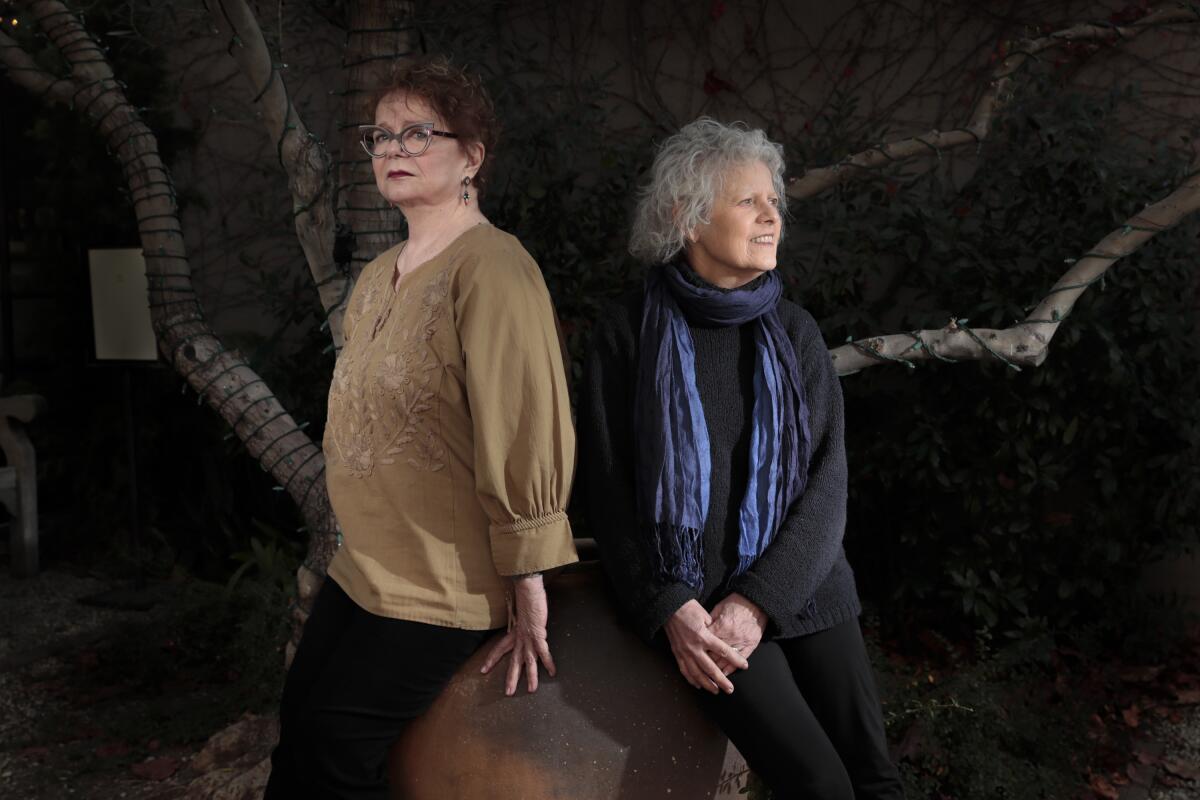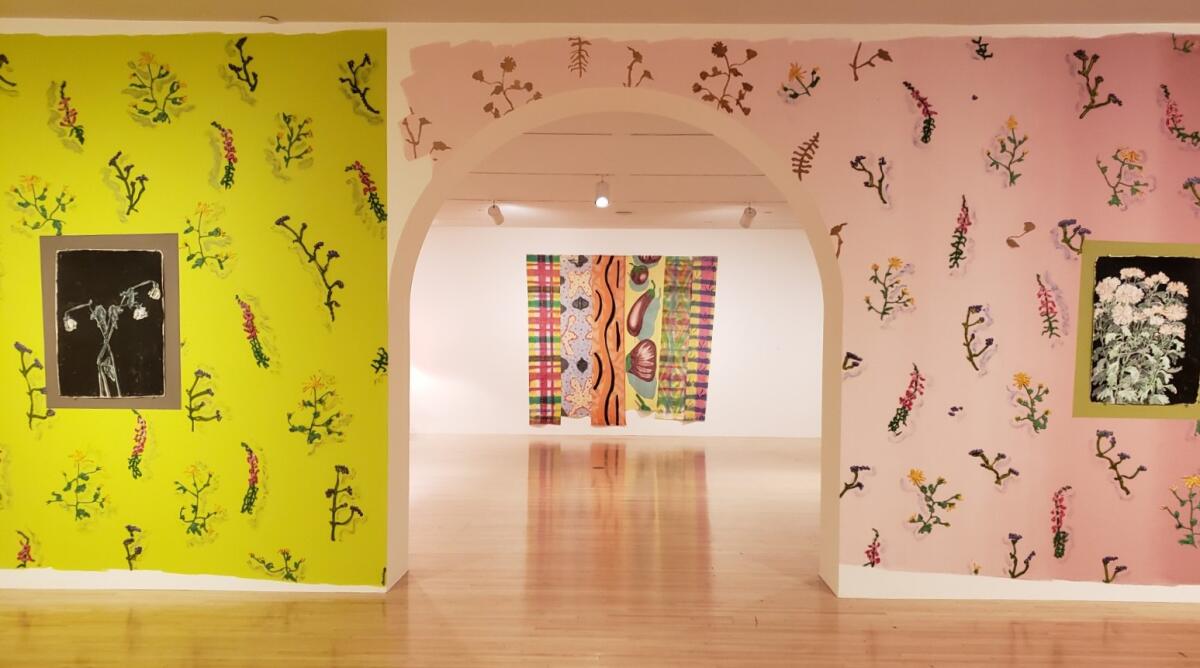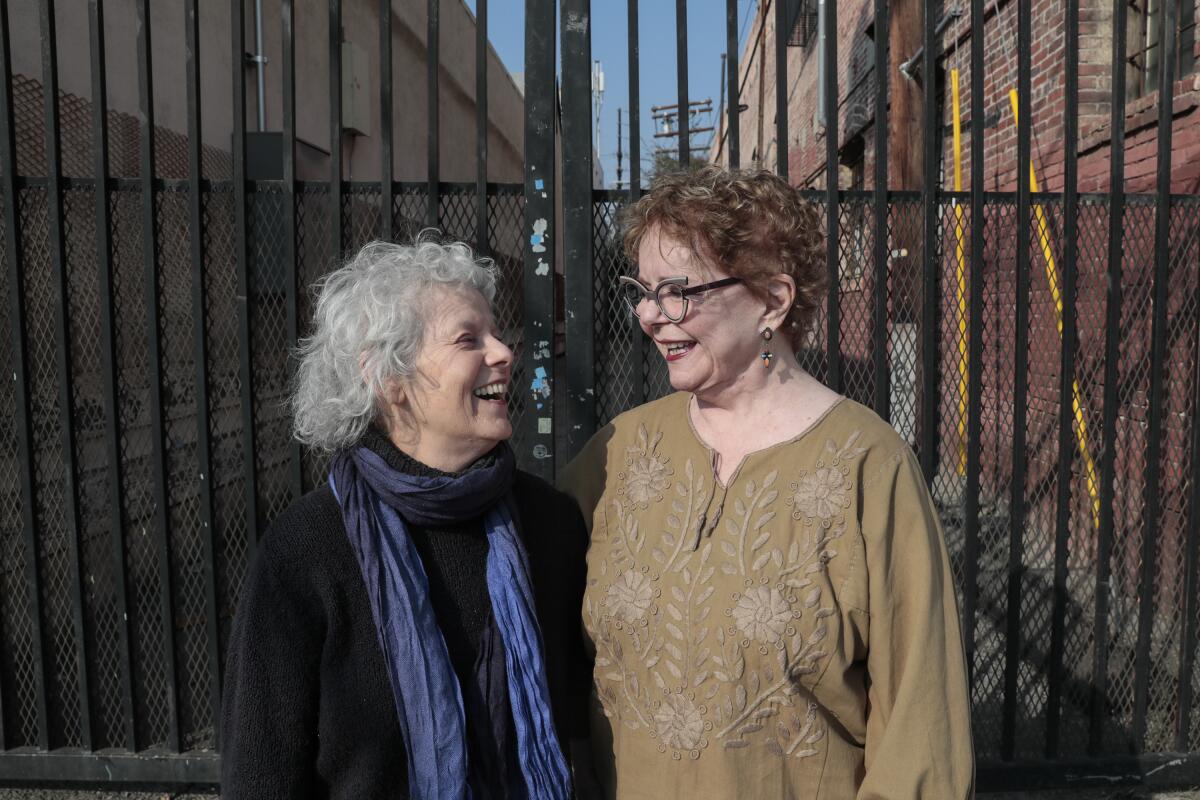A story of art that is also a story of feminism and female friendship

It was the late 1960s and early ’70s, a moment in which the art establishment was in a full-on bromance with Minimalism: stacked boxes, chilly neon, hand-drawn grids, not to mention all that trippy SoCal Light and Space. Enter the Pattern and Decoration movement — which arrived like a flying glitter bomb.
Where Minimalism had exercised ascetic levels of restraint, Pattern and Decoration, known as P&D, went for the jugular of ebullience. This was a movement intrigued by the vibrancy of wallpaper and textile designs, Latin American ceramics, Islamic patterns and even candy boxes. Its most extraordinary works often incorporated the most ordinary craft materials. Glitter! Ribbons!
The movement included prominent male artists, such as Billy Al Bengston and Kim MacConnel. But its rise intersected with the rise of the women’s movement and feminist art, which gave primacy to objects that were linked to women’s experiences and the domestic. As a result, some of its most notable practitioners were women — and they were from Los Angeles. (The city lay within the orbit of the newly launched feminist art program at CalArts, which was founded by P&D artist Miriam Schapiro in collaboration with Judy Chicago.)

In the thick of it were Constance Mallinson, now 71, and Merion Estes, 81, two L.A. painters whose work now hangs within steps of each other in the historic group exhibition “With Pleasure: Pattern and Decoration in American Art 1972-1985,” on view at the Museum of Contemporary Art’s Grand Avenue location through May. Estes is showing a large canvas with a buoyant floral pattern, while Mallinson has a trio of works inspired by basket-weave patterns on display.
The first full accounting by a major museum — MOCA — of the 1970s P&D movement delivers a sharp, well-placed jab to the art world’s solar plexus.
The artists aren’t just colleagues, however. They are close friends — the kind who finish each other’s sentences.
Estes was raised in San Diego and left to complete her university studies in New Mexico and Colorado. Mallinson grew up in Washington, D.C., and attended the University of Georgia. Both relocated to Los Angeles in the 1970s. It was here that they forged a bond — first by sharing a studio in a dilapidated industrial building on Winston Street in an era in which downtown transformed into a graveyard after dark. Then, by their shared interest in making art that lay outside the dominant canon.
“Having that interest in craft was kind of an outside position to take,” Mallinson says. “Craft was not taken seriously.”
Through the years, they have also served as each other’s support network and artistic sounding board. In 2006, Mallinson, who is also a critic, wrote the catalog essay for Estes’ solo show at the Pomona College Museum of Art, “A Sea of Possibilities: Paintings by Merion Estes 1971 to 2006.” Estes, in turn, recommended that the museum’s curators have a look at Mallinson’s work. In 2009, Mallinson had her own solo show at the museum.
“What can I do for you — that’s feminism,” says Estes. “That’s being conscious.”
When American aerial bombing of Baghdad began in March 2003, spectacular visual splendor fused with cruel carnage and death.
In this interview, the pair talk about Los Angeles, the unsung charms of glitter as art material and how the belated success of a movement like P&D depended not on the art market or big-name collectors, but on everyday women supporting each other.
What was downtown L.A. like when you landed?
Estes: It was exciting and fun and there were wild parties. I may have hosted some of them. [Laughs.]
Mallinson: Mike Kelley was constantly doing performances. And Jim Shaw. What an incredible dancer. He had the best moves.
Estes: He would do things like fling his body against the wall and things like that. Years later, I mentioned to him, “You are the best dancer.” And he was like, “Hmmph.”
Mallinson: I remember I worked for [industrial designer] Gere Kavanaugh. She was two blocks away in Little Tokyo. She’s a real character. I’d gotten that job through another artist. The work that is the Pattern and Decoration show at MOCA, I made while I was working for her.
Estes: [Kavanaugh] was really great. I took [Constance’s] job when she moved to the [San Fernando] Valley. Gere paid 15 bucks an hour, which was a lot in those days.
Mallinson: I would not have called Gere a feminist, but she was tough and she was resilient and she was a good designer.
Estes: And she didn’t take anything from anybody.
Mallinson: She made it her business to get work — from Frank Gehry, from the big architectural firms. She really created a very distinctive style and made a mark on the design community. She was also extremely supportive. She came to all my shows.
How did you come to the Pattern and Decoration movement?
Estes: Here comes a sob story. I got pregnant in high school and my nice liberal parents kicked me out. I was told, “This is your life now. You’re not going to be an artist.”
My art teacher was devastated on my behalf. I had two more children. So then I find myself married with three babies. But my husband was not providing any income or support, and I had to get out. I thought, “This isn’t going to stop me.”
My high school teacher, Ms. Marge Hyde, had been made chair of the local junior college. So I got my nerve up and I went back to school. Anyhow, through my mother’s second husband, who liked me quite a lot, he let me live in their rental house in Albuquerque so I could transfer to the University of New Mexico.
It changed my life. The influence of the Native American textiles and crafts, I just fell in love with the whole thing — not to mention the landscape. When I go back, I get tears in my eyes. I had never been so conscious of landscape before.
Mallinson: I had nothing like Merion’s experience. I was a fairly conventional painter at that point. My earliest work was pretty minimal — you almost had to get your card as a minimalist to practice art. The pattern work didn’t happen until I moved out here. I started to really explore and connect with feminist artists and feminist art theory. I wanted to change from the hardcore reductive work that I was doing to something more personal and this type of work felt really personal to me.
There’s a real sensuousness to P&D.
Estes: It’s very fertile and referencing life — real life, not just from academia.
Mallinson: The body is writ large in that show, the female body. For me, the tiny insistent repetitious marks were a way for me to assert my female body and presence. There is an insistence in building up a surface of thousands and thousands of tiny marks that is quite different from casting a piece with steel. This is my body engaging with the material.
Estes: I was trying to get rid of the grid composition.The painting in the MOCA show, it is dissolving. The grid pattern is reduced to a circular pattern of floral shapes. The grid had been everything. But the background, which I’d been slapping on the canvas with a homemade brush, that became more important, more dominant.
Mallinson: Everything was grid! The leftovers of minimalism.
How engaged were you with feminist issues at this point?
Estes: I and other graduate students, Connie Jenkins and Leslie Salisbury, we organized the female grad students [at the University of Colorado in Boulder]. We wanted many things, like female teachers, female visiting artists. The faculty was all male. They had all the power. We went to the newspaper in Boulder to make an exposé about the faculty. I was so scared. [Laughs.] I was shaking in the reporter’s office. The year after we agitated, it changed.
Mallinson: I was really starting my reading at that point. There was Mary Beth Edelson, the doyenne of the D.C. feminist art scene. I had other friends. I had been part of a sit-in at the University of Georgia because women had to be in at 11 o’clock at night, but men could stay out whenever. We also couldn’t wear pants. They threatened to kick us all of out of school because we wanted to wear pants and stay out past 11.
Estes: So we effected change.
Mallinson: This was ’68. It was in the air!
How were you connected to the feminist art scene in Los Angeles?
Estes: There was Womanspace [a feminist gallery], and the Woman’s Building [a downtown hub for feminist art and education], that was being organized at the time by Judy Chicago and Sheila de Bretteville. This was when I had just hit town. Of course, since we had been rabble rousers in graduate school we were looking for feminist activity here. I was reading the more radical feminists like Shulamith Firestone, and I was like, I don’t give a ... about men who want to see my work. I want to make work for women.
Mallinson: And it was the era of the women’s show. But in a positive way. It wasn’t seen as ghettoizing. It was empowering.
Estes: My first eight shows were women-derived and women participants. I was fine with it. It was radical. [Womanspace] was on Venice Boulevard in a former laundromat and a lot of us worked on tearing out the space and putting up drywall and painting. Then it opened. And it was a community center, there were exhibitions there, there were lectures. I saw Anaïs Nin there in person — it was like, oh, my God. [Painter] June Wayne came and talked about money. I always remember her message, which was: Stay away from the IRS. [Laughs.]
Mallinson: I was not here for what Merion is describing. But I did see what happened later. It became clear to me after a short time of being here is that this really was about women helping women.
Estes: The consciousness-raising groups. I had done that in Boulder, and that was electrifying. It’s like, “Oh, you too?” There were grisly stories sometimes about husbands and boyfriends and inequities, but the acknowledgment that we had shared the same experiences — it was fantastic.
Mallinson: What I realized at that point was that women really needed to support one another. This became a commitment of mine. I had started writing and I knew the power of that. It is tremendously powerful to write about art — the changes you could make for women by doing that. And it was a community effort.
I remember when I’d had my first child, I couldn’t get time to write anything. Merion’s show came up, but I couldn’t get any time. And Merion was like, “I will babysit the kid.” And I was like, “Deal on.” That showed you the reciprocity you needed to keep moving forward.
What drew you to each other’s work?
Mallinson: When we met, Merion’s work represented what I wasn’t. She was using glitter and sequins and these overtly ...
Estes: ... tasteless?
Mallinson: ... garish and wonderful materials. I was so taken with that. The exuberance and the full embrace of a feminine and decorative aesthetic. It was an inspiration to see someone so boldly take that on. I know that helped me grow and try new things.
Estes: Likewise, I remember being electrified by those textures [in the basket weave works] and those landscape vignettes with the scratching in the plaster. I had little tingles. It seemed to me really bold. I knew you were onto something really big and I was a little jealous.
Mallinson: Jealousy is always in the air. But there is a genuine sense of joy when someone you respect so much and have developed a deep relationship with gets art world recognition.
Estes: There was a real camaraderie. We were all downtown girls together.

With Pleasure: Pattern and Decoration in American Art 1972-1985
More to Read
The biggest entertainment stories
Get our big stories about Hollywood, film, television, music, arts, culture and more right in your inbox as soon as they publish.
You may occasionally receive promotional content from the Los Angeles Times.







